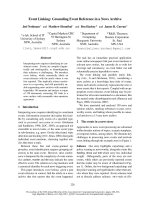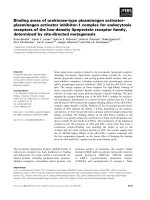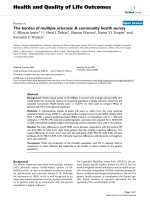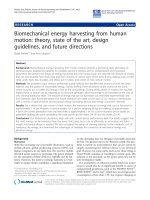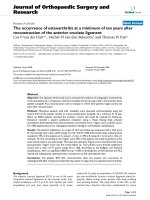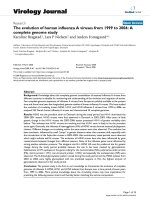Báo cáo hóa học: " Binding Energy of Hydrogen-Like Impurities in Quantum Well Wires of InSb/GaAs in a Magnetic Field" pdf
Bạn đang xem bản rút gọn của tài liệu. Xem và tải ngay bản đầy đủ của tài liệu tại đây (273.67 KB, 4 trang )
NANO EXPRESS
Binding Energy of Hydrogen-Like Impurities in Quantum Well
Wires of InSb/GaAs in a Magnetic Field
B. Zh. Poghosyan
Received: 19 May 2007 / Accepted: 27 July 2007 / Published online: 22 September 2007
Ó to the authors 2007
Abstract The binding energy of a hydrogen-like impurity
in a thin size-quantized wire of the InSb/GaAs semicon-
ductors with Kane’s dispersion law in a magnetic field B
parallel to the wire axis has been calculated as a function of
the radius of the wire and magnitude of B, using a varia-
tional approach. It is shown that when wire radius is less
than the Bohr radius of the impurity, the nonparabolicity of
dispersion law of charge carriers leads to a considerable
increase of the binding energy in the magnetic field, as well
as to a more rapid growth of binding energy with growth
of B.
Keywords Quantum well wire (QWW) Á
Hydrogenlike impurity Á Binding energy Á
Magnetic confinement
Introduction
The investigation of shallow impurity and excitonic states
in various confined systems, such as quantum wells,
quantum well wires (QWW) and quantum dots (QD) [1–3]
in external magnetic and electric fields are of great interest
for a better understanding of their properties, as well as for
their potential application in optoelectronic devices [4, 5].
Photospectroscopy experiments, carried out on n-type
GaAs in magnetic fields, have revealed transitions involv-
ing the so-called metastable impurity states [6]. These
states, associated with the free electron Landau levels,
modified by the Coulomb interaction between the donor ion
and electron, are known as Landau-like states [7].
In earlier work, Zhilich and Monozon [8] variational
procedure to calculate the energies of Landau-like states of
shallow donors is used. However, this method applies only
for extreme values of magnetic field. The variational
method of investigating these states were developed in [9–
16] as well as in [7] for a semiconductor with parabolic
bands.
At present the stage of experimental and theoretical
investigations of Landau-like states in bulk semiconductors
and their heterostructures, may be considered completed.
Of great interest is the study of Landau-like states in low-
dimensional semiconductors, since the reduction of
dimensionality leads to an increase in binding energy of
Landau-like states. Investigations in magnetic fields are of
particular interest for understanding the basic physical
properties of nanostructures, in particular, of QWW. Here,
magnetic confinement potential competes with the geo-
metric confinement potential depending on the strength and
orientation of B [17]. The magnetic length can be varied
from values which are larger than the typical lateral
dimensions of QWW and QD, to values which are smaller
than these dimensions.
The binding energy of the ground state of a hydgrogenic
donor in a GaAs QWW in the presence of a uniform
magnetic field has been calculated in [18]. The calculations
were performed for an axial localization of the impurity for
the cases of both infinite and finite potential barriers.
The calculation in [18–22] are carried out within the
framework of the effective-mass approximation for the
semiconductor QWW with parabolic bands. The calcula-
tions of the binding energy of the hydrogen-like impurity in
magnetic field in a QWW of A
3
B
5
semiconductors with
nonparabolic bands is of great interest. A
3
B
5
semiconduc-
tors usually have small effective masses, great dielectrical
constant v, which means that the Bohr radius of the
B. Zh. Poghosyan (&)
Gyumri State Pedagogical Institute, 4 P. Sevak street, Gyumri
3126, Armenia
123
Nanoscale Res Lett (2007) 2:515–518
DOI 10.1007/s11671-007-9084-2
impurity is larger in comparison with QWW radius
achievable at present. It should be noted that the binding
energy of the hydrogen-like impurity increases when the
size of the confining potential is of the order or less of than
the Bohr radius [23].
The binding energy of the hydrogen-like impurity in a
QWW of A
3
B
5
semiconductors has been calculated in [24]
as a function of the radius of the wire and the location of
the impurity with respect to the axis of the wire, using a
variational approach. It is shown that the binding energy in
Kanes semiconductors [25] is larger than in standard case
for all values of the shift parameter.
As it is known [26], the nonparabolicity of the disper-
sion law leads to a considerable increase of the binding
energy in the magnetic field, as well as to a more rapid
nonlinear growth of binding energy with B.
The binding energy of a hydrogen-like impurity in a thin
size-quantized wire of InSb/GaAs semiconductors [27]
with Kane’s dispersion law has been calculated as a
function of the radius of the wire and the location of the
impurity with respect to the axis of the wire, using a var-
iational approach. It is shown that when wire radius is less
than the Bohr radius of the impurity, the nonparabolicity of
dispersion law of charge carriers leads to a considerable
increase of the binding energy.
In this paper this analogy is applied for the investigation
of binding energy of hydrogenlike shallow donor in a thin
size-quantized wire of the InSb/GaAs semiconductors in a
magnetic field, parallel to the wire axis. Calculations have
been performed using the variational approach, developed
in [27].
Binding Energy Calculations
Consider the system consisting of the semiconducting wire
of radius R
1
with the dielectric constant v
1
, having the
coating of radius R
2
immersed in the infinite environment
(Fig. 1a).
In the system under consideration, when the potential
energy of an electron is of the form (Fig. 1b) in the pres-
ence of a magnetic field B, parallel to the wire axis, we’ll
approximate the wire potential by the finitely high potential
well
VðrÞ¼
0; q\R
1
;
V
0
; R
1
q R
2
;
1; q [ R
2
;
8
<
:
ð1Þ
where V
0
is the value of the potential energy jump at the
boundary of the wire and the coating layer
(V
0
=(E
g2
ÀE
g1
)Q). In two-band approximation of Kane’s
dispersion law, analogous to the relativistic law of
dispersion [26], the eigenfunctions and eigenvalue spectra
of electron are the solutions of the Klein-Gordon equation
in the wire of InSb and GaAs with standard dispersion law
l
2
s
4
þ s
2
^
p þ
e
c
A
2
!
W
10
¼ðE
0
þ ls
2
Þ
2
W
10
; ð2Þ
^
p þ
e
c
A
ÀÁ
2
2l
W
20
þ V
0
W
20
¼ E
0
W
20
; ð3Þ
where s is the parameter characterizing the nonparabolicity
of bands (s& 10
8
cm/s, l = 0.016 l
0
for InSb) and related
with the forbidden bandgap E
g
by the relation E
g
=2ls
2
with the boundary condition W(R)=0, A is chosen as
A ¼ A
u
¼ Bq=2; A
q
¼ A
z
¼0
ÈÉ
[26].
The solution of the Eq. (1) in cylindrical coordinates
normalized within the range q R and q ! R are
W
0
ðq; u; zÞ
¼
N
0
ffiffiffiffiffiffi
2pL
p
e
ikz
e
Àn=2
1
F
1
ðÀa
01
; 1; nÞ; 0 q\R
1
;
N
0
ffiffiffiffiffiffi
2pL
p
e
ikz
e
Àn=2
1
F
1
ðÀa
01
;1;n
R
Þ
UðÀa
0
01
;1;n
R
Þ
UðÀa
0
01
; 1; nÞ; R
1
q R
2
;
0; q [R
2
;
8
>
>
<
>
>
:
ð4Þ
where N
À2
0
¼ a
2
c
R
n
R
0
e
Àn
n
m
jj
1
F
2
1
ðÀa
m
jj
;l
; m
jj
þ1; nÞdn is the
normalization constant, L is the wire length, k, m, l are
quantum numbers, n = q
2
/2a
c
2
, a
c
¼ "hc=eBðÞ
1=2
is
magnetic length,
1
F
1
(a, b, n) is the confluent
hypergeometric function, a
|m|l
is determined by the
boundary condition that the wave function vanishes at the
surface of the wire, when q = R
1
F
1
ðÀa
m
jj
l
; m
jj
þ 1; d
2
=2a
2
c
Þ¼0:
For the electron energy spectrum we have
0
r
1
R
2
R
1
χ
2
χ
b)
a)
sAaG
I bSn
V(r)
1
µ
2
µ
B
Fig. 1 Schematic drawing of the system
516 Nanoscale Res Lett (2007) 2:515–518
123
E
0
¼Àls
2
þ
ffiffiffiffiffiffiffiffiffiffiffiffiffiffiffiffiffiffiffiffiffiffiffiffiffiffiffiffiffiffiffiffiffiffiffiffiffiffiffiffiffiffiffiffiffiffiffiffiffiffiffiffiffiffiffiffiffiffiffiffiffiffiffiffiffiffiffiffiffiffi
l
2
s
4
þ "h
2
s
2
k
2
z
þ 2ls
2
"hxa
01
þ 1=2ðÞ
q
¼
P
2
z
2l
þ V
0
þ "hxa
0
01
þ 1=2
ÀÁ
; ð5Þ
where k
z
is the z-component of the wave vector, x = eB/l c.
The equations determining the electronic states in an InSb/
GaAs semiconductor wire in the case when a fixed Coulomb
center is localized on the wire axis, with the potential
Uðq; zÞ¼À
e
2
v
ffiffiffiffiffiffiffiffiffiffiffiffiffiffiffi
q
2
þ z
2
p
in the presence of a magnetic field B, are
l
2
s
4
þ s
2
^
p þ
e
c
A
2
W
1
¼ E þls
2
þ Uðq; zÞ
ÀÁ
2
W
1
;
ð6Þ
^
p þ
e
c
A
ÀÁ
2
2l
W
2
þðV
0
À Uðq; zÞÞW
2
¼ EW
2
: ð7Þ
To determinate hydrogen-like impurity states we shall
apply the variational method developed in [18]. For the
ground state (m =0,l = 1), we shall choose the trial wave
function in the from
Wðq;u;zÞ
¼
Ne
Àn=2
1
F
1
ðÀa
01
;1;nÞe
Àk
ffiffiffiffiffiffiffiffiffi
q
2
þz
2
p
; q\R
1
;
Ne
Àn=2
1
F
1
ðÀa
01
;1;nÞ
R
Þ
UðÀa
0
01
;1;n
R
Þ
UðÀa
0
01
;1;nÞe
Àk
ffiffiffiffiffiffiffiffiffi
q
2
þz
2
p
; R
1
q R
2
;
0; q[R
2
;
8
>
>
<
>
>
:
ð8Þ
where k is the variational parameter, N
À2
¼À2p
d
dk
ðKþMÞ
is the normalization constant,
K ¼
Z
R
0
e
Àq
2
=2a
2
c
1
F
2
1
ðÀa
01
; 1; q
2
=2a
2
c
ÞK
0
ð2kqÞqdq;
M ¼
1
F
1
ðÀa
01
; 1; n
R
Þ
UðÀa
0
01
; 1; n
R
Þ
Z
1
R
e
Àq
2
=2a
2
c
U
2
ðÀa
0
01
; 1; q
2
=2a
2
c
ÞK
0
ð2kqÞqdq;
K
0
(2kq) is the modified Bessel function of the second
order, U
2
(Àa
0
01
,1;n) and
1
F
1
(a, b, n) is the confluent
hypergeometric functions.
Taking into consideration Eqs. (6)–(8), and (5) the
binding energy, as well as in [26], is found as the difference
E
b
(R,B)=E
01
À E
i
(R,B).
Discussion of Results
The dependence of binding energy of the impurity in effec-
tive Rydberg R
*
in the InSb/GaAs quantum wire from the
wire thickness in dimensionless units y
1
= R
1
/a, k ? k a,
a = a
10
a (a is the effective Bohr radius of impurity
a =500A
˚
, a ¼ "h
2
v=le
2
; Q =0.6), x = a
10
R =2.4048,
q = tR for two different values of magnetic field (B
1
=10T
and B
2
= 40 T) are shown on Fig. 2 (curves1 and 2).
The analogous curves 1
0
and 2
0
are for a semiconductor
QWW with parabolic dispersion law GaAs/AlAs, obtained
in [18].
As follows from Fig. 2, the curves 1 and 2 as well as 1
0
and 2
0
coincide at y? 0 (practically in the range y 0.1);
in an infinite barrier case the binding energy diverges,
when y ? 0 for any magnetic strength. At such values of
the QWW radius the binding energy of impurity is mainly
determined by geometric confinement of QWW. The
binding energy in the nonparabolic case is essentially
greater than in a parabolic case at the same values of the
wire radius and the magnetic field.
Thus in units R
*
at y
1
> 0.4 (y
2
= R
2
/a, R
2
= a/2) our
results are close to the results of [18]. For the case
B = 10 T, when y > 0.4 (R > 200 A
˚
) the values of binding
energies for InSb/GaAs and GaAs/AlAs semiconductor
wires are actually the same. The nonparabolicity doesn’t
play essential role when the radius of wire is big enough.
This increase is considerable when wire thickness is less
than the Bohr radius of an impurity electron (y
1
< 0.4).
The dependence of binding energies in effective Ryd-
berg R
*
on the values of the magnetic field B in InSb/GaAs
quantum wire for various thickness (y
1
= 0.2, R
1
= 100 A
˚
and y
2
= 0.4, R
2
= 200 A
˚
) are shown on Fig. 3 (the curves
1 and 2). As on Fig. 3, the curves 1
0
and 2
0
are shown for a
hypothetical QWW with parabolic bands, but with the
same parameters as in InSb/GaAs. For a fixed value of d
the binding energy in both cases increases as a function of
the magnetic field due to the increasing compression of the
wave function with magnetic field. As follows from Fig. 3,
at one and the same value of y the growth of binding
energy depending on the magnetic field is more rapid for a
Fig. 2 The binding energy of the ground state of hydrogen-like
impurity (in units of R
*
) as a function of y
1
in the magnetic field
(1, 1
0
—B =10T;2,2
0
—B = 40 T), when impurity center is localized
on the wire axis: 1,2—for the InSb/GaAs quantum wire; 1
0
,2
0
—for the
GaAs/AlAs semiconductor wire
Nanoscale Res Lett (2007) 2:515–518 517
123
nonparabolic dispersion law in comparison with a para-
bolic case. As in [18] the binding energy growths more
rapidly from magnetic field in thick wires.
When B ? ? the geometric confinement of QWW does
not play any role and the binding energy is defined by the
magnetic confinement. Fig. 3 shows that difference in
binding energies for InSb/GaAs and GaAs/AlAs are more
essential for a 100 A
˚
wire than for 200 A
˚
wire for the same
value of B = 10 T. In the range B <10T(R = 200 A
˚
),
when the nonparabolicity is not substantial [24], a coinci-
dence of the asymptotic behavior of the corresponding
curves for InSb/GaAs QWW (1) and for GaAs/AlAs QWW
(1
0
) was observed. In the range B ! 40 T the binding
energies for 200 A
˚
-wire (with nonparabolic dispersion law)
have the same value as for 100 A
˚
-wire (with parabolic
dispersion law).
At y ?0, the binding energy approaches infinity E
b
?
?, which is related with the choice of the infinite well
model, for the wire potential. For a quantative comparison
with the experimental data we used Larsen’s results [28]
for the binding energy of shallow impurity in such a
magnetic field B that creates the same confinement, as the
wire potential, i.e.:a
H
¼
ffiffiffiffiffiffiffiffiffiffiffiffiffi
c"h=eH
p
% R [26]. In the case
when y
1
= a
c
/a = R
1
/a = 0.2 we have obtained the fol-
lowing value for the binding energy E
b
= 8.5R
*
, (in InSb
R
*
= 0.6 Á 10
À3
eV). In the semiconductor wire of GaAs/
AlAs E
b
= 7.7R
*
.
As it follows from the dependence obtained (see Fig. 2
or Fig. 3), the binding energy in Kane’s semiconductors is
greater than the similar quantity in a standard case for all
values of the wire radius and the magnetic field.
I’d like to express my gratitude to Dr. Wang and my
colleague Dr. Dvoyan for attention towards my research.
References
1. P. Harrison, Quantum Wells, Wires and Dots: Theoretical and
Computational Physics (University of Leeds, Leeds, United
Kingdom, 1999)
2. D. Bimberg, M. Grundmann, N. Ledentsov, Quantum dot Het-
erostructures (Wiley, 1999)
3. J. Cibert, P.M. Petroff, G.J. Werder, S.J. Pearton, A.C. Gossard,
J.H. English, Superlattice. Microst. 3, 35 (1987)
4. P. Ramvall, S. Tanaka, S. Nomura, P.Riblet, Y. Aoyagi, App.
Phys. Lett.73,1104 (1998)
5. E.L. Ivchenko, A.V. Kavokin, V.P. Kochereshko, Rev. B, 46, 773
(1992)
6. H.P. Wagner, W. Preffl, Solid State Commun. 66, 367 (1988)
7. P.W. Barmby, J.L. Dunn, C.A. Bates, Phys. Rev. B, 54, 8566
(1996)
8. A.G. Zhilich, B.S. Monozon, Sov. Phys. Solid State, 8, 2846
(1967)
9. N. Lee, D.M. Larsen, B. Lax, J. Phys. Chem. Solids 34,1059
(1973)
10. C. Aldrich, R.L.Greene, Phys. Stat. Sol. (b) 93, 343 (1979)
11. Y. Yafet, R.W. Keyes, E.M. Adams, J. Phys. Chem. Solids 1, 137
(1956)
12. D.M. Larsen, J. Phys. Chem. Solids 29, 271 (1968)
13. P.C. Makako, N.C. McGill, J. Phys. C 19, 873 (1986)
14. J.M. Shi, F.M. Peeters, J.T. Devreese, Phys. Rev. B 48, 5202
(1993)
15. G. Golubev et al., Soviet Phys-Semicond. 22, 896 (1988)
16. G. Wunner, H. Ruder, Phys. Lett. A 85, 430 (1981)
17. M. Bayer, P. Ils, M. Michel, A. Forchel, Phys. Rev. B 53, 4668
(1996)
18. S.V. Branis, G. Li, K.K. Bajaj, Phys. Rev. B 47, 1316 (1993)
19. S.T. Perez-Merchancano, G.E. Marques, Phys. Stat. Sol. (b) 212,
375 (1999)
20. F.A.P. Osorio, A.N. Borges, A.A. Caparica, J.R. Leite, Solid
State Commun. 103, 375 (1997)
21. M. El-Said, Semicond. Sci. Technol. 9, 1787 (1994)
22. I. Zorkani, A. Mdaa, R. Elkhenifer, Phys. Stat. Sol. (b), 215, 1005
(1999)
23. J.W. Brown, H.N. Spector, J. Appl. Phys., 59, 1179 (1986)
24. A.A. Avetisyan, A.P. Djotyan, E.M. Kazaryan, B.Zh. Poghosyan,
Phys. Stat. Sol. (b), 218, 441 (2000)
25. E.O. Kane, J. Phys. Chem. Solids 1, 249 (1957)
26. A.A. Avetisyan, A.P. Djotyan, E.M. Kazaryan, B.Zh. Poghosyan,
Phys. Stat. Sol. (b) 225, 423 (2001)
27. B.Zh. Poghosyan, G.H. Demirjian, Physica B, 338, 357 (2003)
28. D.M. Larsen, J. Phys. Chem. Sol.
29, 271 (1968)
Fig. 3 The binding energy of the ground state of hydrogen-like
impurity (in units of R
*
) as a function of B (1, 1
0
—y = 0.4; 2, 2
0
—y
= 0.2), when impurity center is localized on the wire axis: 1,2—for
the InSb/GaAs quantum wire; 1
0
,2
0
—for semiconductor wire with
standard dispersion law GaAs/AlAs
518 Nanoscale Res Lett (2007) 2:515–518
123

